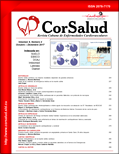Muerte súbita cardiovascular intrahospitralaria e infarto agudo de miocardio con elevación de ST: Resultados de RESCUE
Resumen
Introducción: La muerte súbita cardiovascular (MSC) constituye uno de los principales desafíos de la cardiología moderna. Luego de un infarto agudo de miocardio con elevación del segmento ST (IAMCEST), las características del miocardio vulnerable pueden conducir a la arritmia final en la etapa intrahospitalaria del tratamiento de estos pacientes.
Objetivo: Identificar asociación entre parámetros al ingreso de los pacientes con IAMCEST y la aparición de MSC intrahospitalaria.
Método: Se realizó un análisis retrospectivo de 251 pacientes consecutivos del registro de síndromes coronarios agudos (RESCUE), que ingresaron con IAMCEST entre junio/2014 y febrero/2016. Se definió como MSC aquella secundaria a rotura cardíaca, arritmias ventriculares malignas o insuficiencia cardíaca aguda. Se establecieron dos grupos de acuerdo a la presencia o no de MSC y fueron recogidas las características morfométricas, los antecedentes de salud, tiempos de actuación de los pacientes y del sistema, y hallazgos clínicos.
Resultados: Los pacientes con MSC fueron mayores (76,6±7,72 vs. 65,1±14,2 años; p=0,001), acudieron más tardíamente al médico (469,4±295,8 vs. 344,1±262,1 minutos), presentaron menor frecuencia de reperfusión (0 vs. 22%; p=0,02) y mayor puntuación en la escala GRACE (129,2±12,58 vs. 101±27,07; p=0,001). Las mujeres presentaron peor pronóstico (55% vs. 30,3% p=0,023), aunque esta diferencia puede ser debido a mayor edad en ese subgrupo (78,45±7,92 vs. 70,23±11,98; p=0,031). El antecedente de tabaquismo se relacionó paradójicamente con la MSC (30% vs. 55,84%; p=0,028).
Conclusiones: La MSC se encuentra asociada a características determinables al ingreso del paciente con IAMCEST.Descargas
Descargas
Publicado
Cómo citar
Número
Sección
Licencia
Aquellos autores/as que tengan publicaciones con esta revista, aceptan los términos siguientes:- Los autores/as conservarán sus derechos de autor y garantizarán a la revista el derecho de primera publicación de su obra, el cuál estará simultáneamente sujeto a la Licencia de reconocimiento de Creative Commons que permite a terceros compartir la obra siempre que se indique su autor y su primera publicación esta revista.
- Los autores/as podrán adoptar otros acuerdos de licencia no exclusiva de distribución de la versión de la obra publicada (p. ej.: depositarla en un archivo telemático institucional o publicarla en un volumen monográfico) siempre que se indique la publicación inicial en esta revista.










